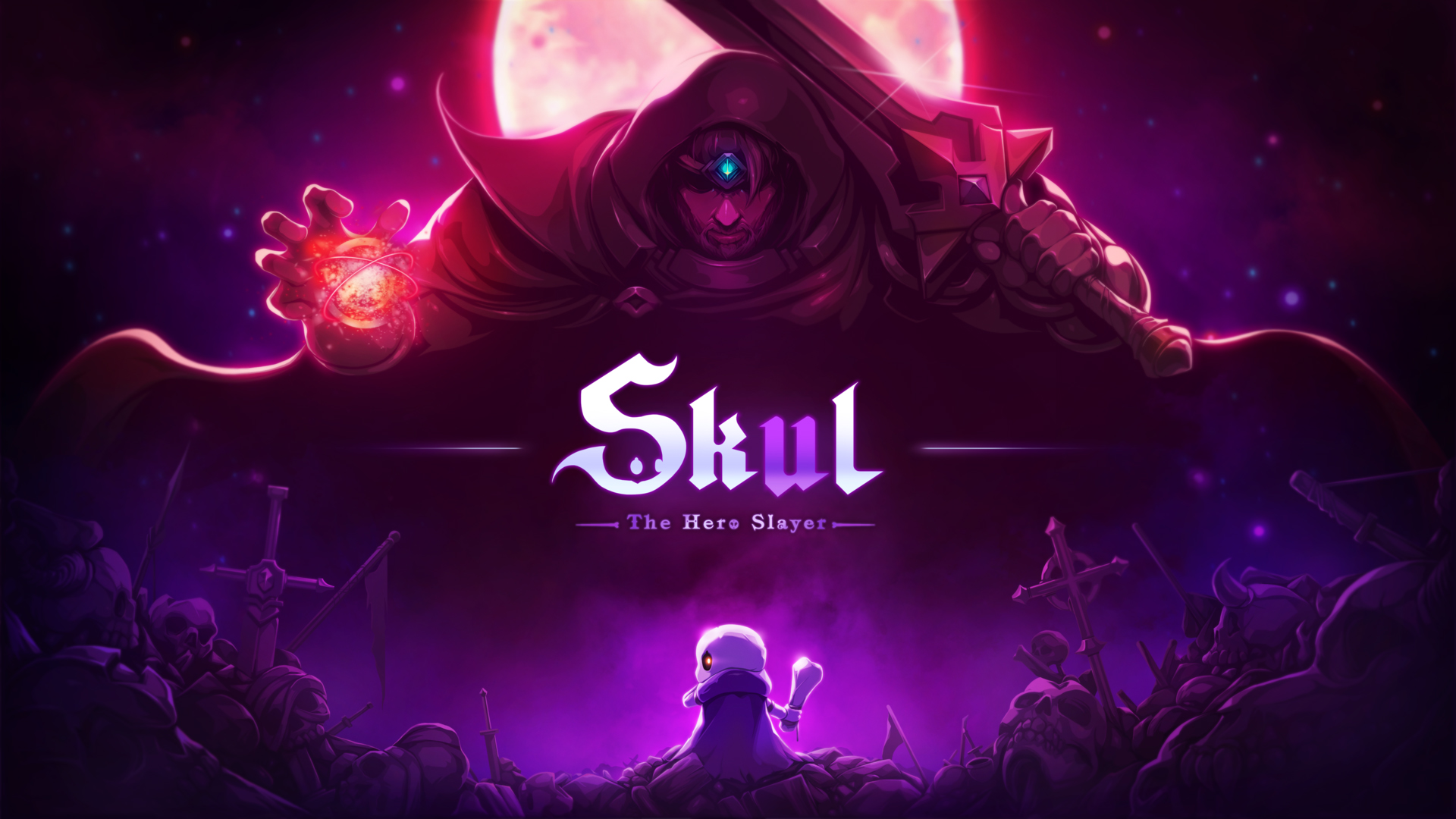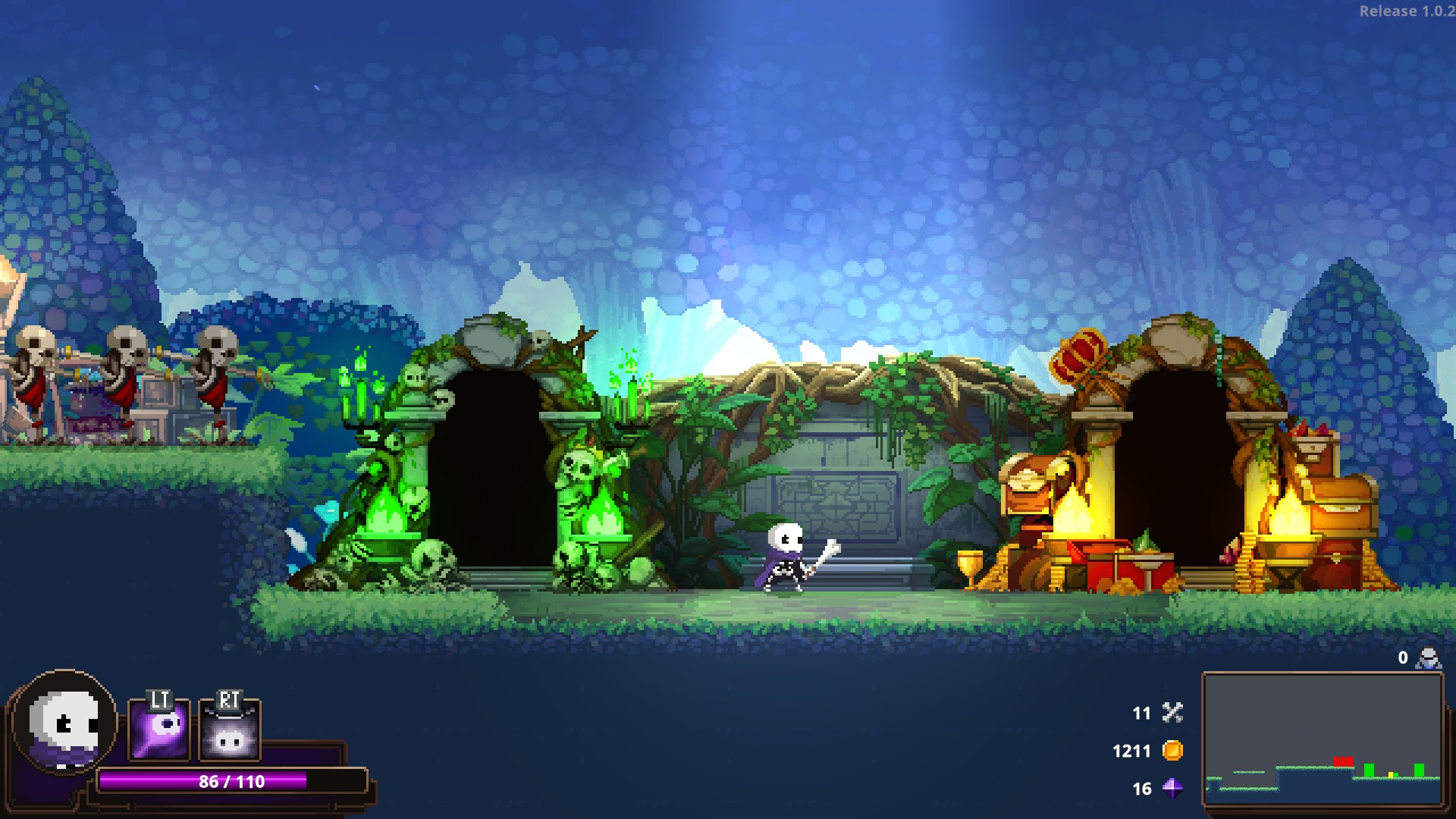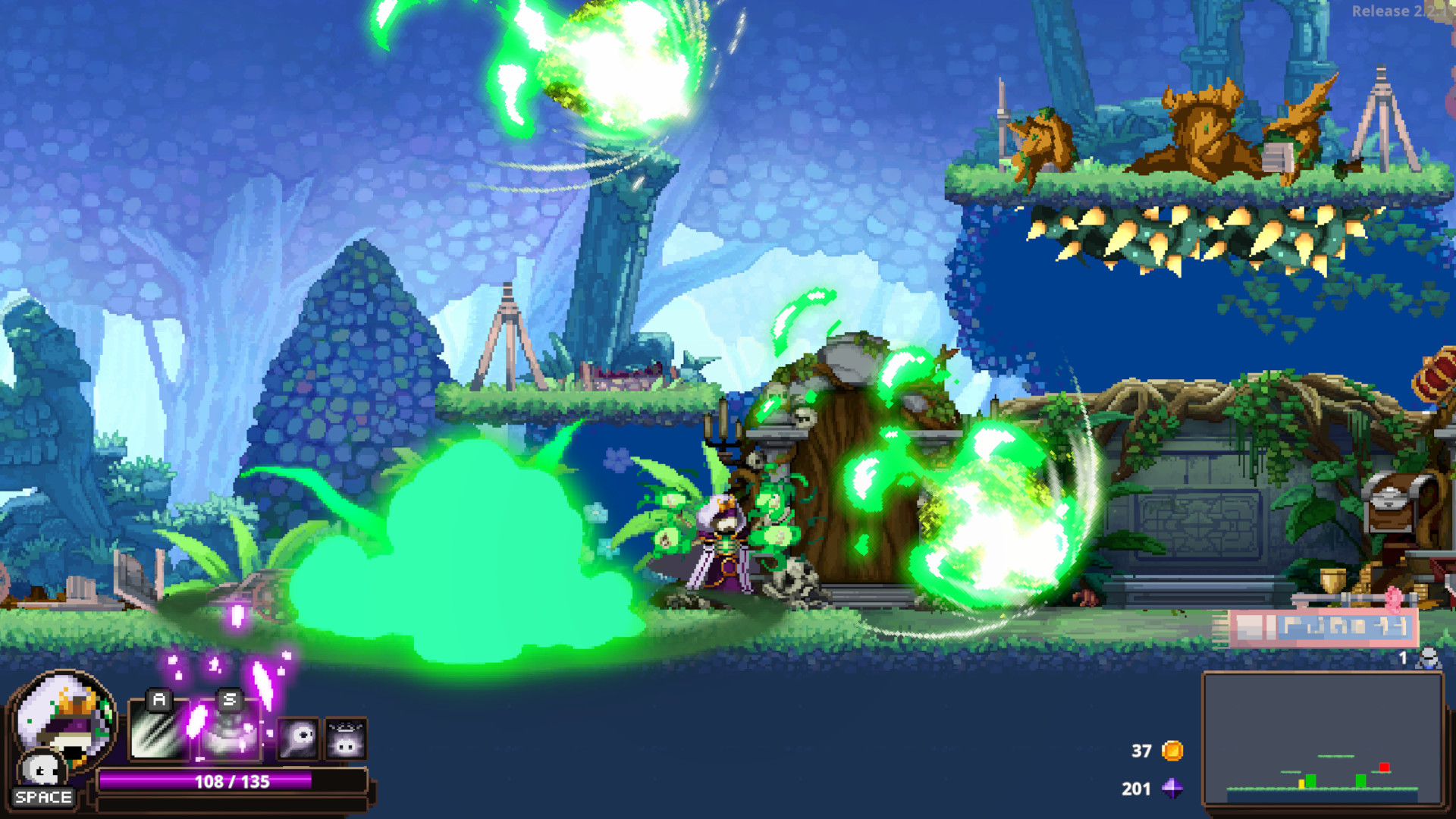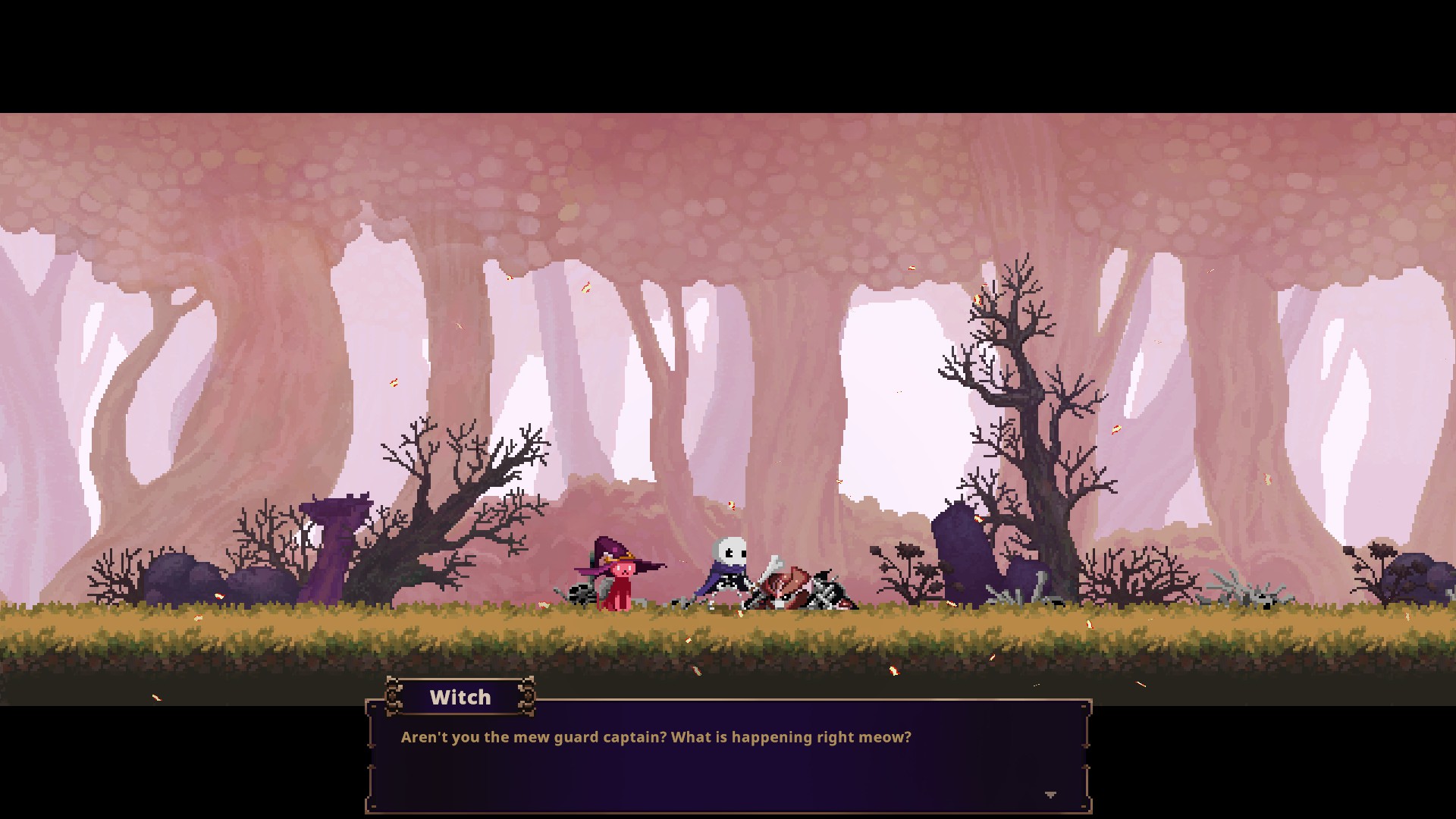Skul: The Hero Slayer is well aware of its genre: pixel art rogue-lite with mild narrative elements. It sits somewhere between Dead Cells and Hades in almost every way, borrowing elements from one and something else from the other. Thankfully, it has its own identity as well, built primarily around its premise: you are the villain in the story. At least by traditional standards.
In this game, the heroes are the generic fantasy mooks you’d kill by the dozens in any other fantasy setting. Orcs, witches, werecreatures — all of them are beset by the heroes of the world until all that remains to save the Demon King is you, a lowly skeleton.
The viewpoint swap creates an opportunity to see the emotional and psychological cost of the reprehensible things humans do when the victims are painted as wholly irredeemable. Make no mistake, some of what you learn throughout Skul would be fodder for any traditional adventure. The difference is it’s built on the backs of monsters who seem much more human than the actual humans you meet.
None of these heavy topics stop Skul from having some truly endearing moments and plenty of charm. Its mechanics are familiar but well-executed, and the enemies you face are as varied as the environments you face them in. I’ll be honest at the start: I can’t find a lot of fault with the game. I have my complaints, but most are minor.
Skul: The Hero Slayer Review — End the Tyranny of Heroes
Many of Skul’s gameplay and design ideas are familiar to anyone who knows the rogue-lite genre. You start with nothing. Do runs. Die. Come back with upgrade materials to increase your power and do more runs. You learn enemies and craft strategies, find out what works for you and what doesn’t, and experiment with new builds even as certain powerful abilities carry you farther than you’re ready for.
You’d be forgiven for thinking you’re getting a Dead Cells-style experience through and through. It won’t take you long to learn that Skul takes a hybrid approach, adding in some of the decision-making Hades demands.
After every room you clear, you’re greeted with two doors offering either gold, an item, or a random skull. The first two are simple. Gold lets you buy stuff, obviously. Items grant passive buffs and automatic abilities. Skulls are where the game comes alive. There are more than a dozen different options that replace the generic character you start with.
Skulls start at Common rarity, and you can upgrade all of them through play, ultimately reaching the borderline-overpowered Legendary version. There are also randomly dropped skulls you can only acquire through skull rooms, and these can do a lot of the heavy lifting even late in a run.
Much of the charm and enjoyment of Skul: The Hero Slayer comes from the various skulls you can upgrade or uncover. You need only look at the Rocker skull. It’s a heavy-metal skeleton that can summon a full band with a light show and pyrotechnics. Why? Who cares? It’s funny and will melt bosses.
The environments and enemy designs are also quite endearing or are as disturbing as they are deadly. The second world is probably my favorite because Skul starts to have fun with its enemies and environments. The third world showcases the depths of human depravity and the last acts in severe contrast to everything that came before.
Moment to Moment Gameplay
As with the mechanics, the arenas sit in a middle ground between Dead Cells and Hades. They are technically randomized as far as their order, but the rooms themselves are static. This lends a level of consistency to each run, provided you’ve seen a room enough times to know what enemies spawn where and when.
You’ll build a definite sense of mastery in a way you might not in other rogue-lites because at the highest level, you’ll know exactly how to play every encounter. No guesswork, no random chance, just knowledge of your skulls and the enemies in front of you.
There’s also a surprising amount of depth to how you can optimize each run. Do you focus on getting the best skull you can find, discarding the rest of the bone pieces for upgrading, or do you max out your gold for heals and easy items? Then, once you have the build you want, do you prioritize additional survivability or straight damage?
Familiar choices, certainly, but far easier to get wrong than execute as effectively as it’s done here in Skul. The reason here is simple: you can be a literal demigod and still watch the bosses or unfamiliar enemies wipe the floor with you. Knowledge and skill are as important as good RNG because you will fail again and again without one.
The bosses themselves are as varied as their levels, and each asks something different of you. Your first go with each of them is likely to result in a quick death, meaning anywhere from 10 minutes to an hour just vanished in a few moments. The later levels also are particularly mean, adding traps and other environmental damage sources that are as likely to end you as any of the enemies themselves.
A Crowded Screen and Other Issues
If I had to name one issue that holds Skul back, it would be how crowded the screen becomes almost as soon as you start playing. The issue only gets worse the farther you get in a run, with your own abilities and those of your enemies mixing into a mishmash of bright color, flashing lights, and other visual noise.
The enemy crowding problem can be especially heinous because there are rooms designed for dozens and dozens of them at a time. There are plenty of abilities that clear rooms quickly, but if you’re on a run without any good clearing moves, one false step can see a random group of ten knights hit you ten times in quick succession.
There are a couple of other annoyances, as well. Some of the rooms are themselves part of the challenge but in an annoying rather than difficult way. Asking for precise platforming in a game where the platforming isn’t stellar isn’t the greatest design choice.
Then there’s the game messing with you. If you’re unlucky, all you’ll see on a run is money and common skulls, with no way to properly increase your power. Some enemies are frustrating rather than difficult, either because of their attacks or because of how hard they can be to hit.
Skul: The Hero Slayer Review — The Bottom Line
Pros
- Addicting gameplay built on solid mechanical foundations
- A welcome twist to traditional fantasy narratives that invites sometimes difficult questions
- High-quality music, art, and overall aesthetic
Cons
- Can fall prey to visual noise that makes gameplay hard to parse
- Some design choices are more frustrating than they are fun
- Less-than stellar platforming controls
Like the core elements of the game, Skul’s music and art direction are high quality, though they aren’t necessarily award-winning. The writing and world-building are good, too, and there are plenty of humorous moments, and little (or not so little) nods to other games. Skeleton puns are always appreciated, as well.
As far as the narrative is concerned, the best part is the way Skul plays with expectations. Combine how it switches good and bad guys, the surprising shifts in some of the later bosses, and its quiet commentary on how we justify atrocity, and Skul elevates itself above some of its peers.
Skul: The Hero Slayer falls into a similar category as something like Ghost of Tsushima. There aren’t many new ideas on display, but everything here’s been polished to a mirror sheen.
The new mechanics add significant flavor and charm to an already solid package. Good music and art combined with satisfying combat and a dash of good humor make the difficulty spikes bearable and the few frustrations bearable.
If you’re looking for a game to scratch your rogue-lite itch with a few fun twists, Skul is a fantastic choice.
[Note: Neowiz games provided the copy of Skul: The Hero Slayer used for this review.]













Published: Feb 3, 2021 10:48 pm